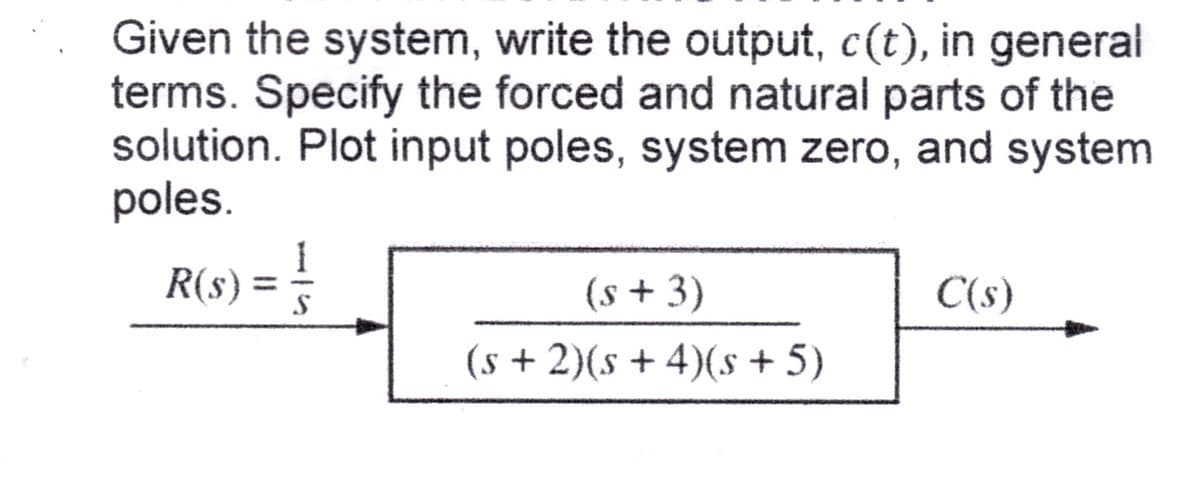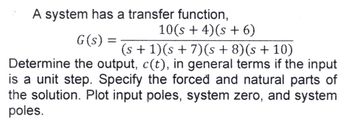Given the system, write the output, c(t), in general terms. Specify the forced and natural parts of the solution. Plot input poles, system zero, and system poles. R(s) = = 1/4 (s + 3) (s + 2)(s + 4)(s + 5) C(s)
Given the system, write the output, c(t), in general terms. Specify the forced and natural parts of the solution. Plot input poles, system zero, and system poles. R(s) = = 1/4 (s + 3) (s + 2)(s + 4)(s + 5) C(s)
Introductory Circuit Analysis (13th Edition)
13th Edition
ISBN:9780133923605
Author:Robert L. Boylestad
Publisher:Robert L. Boylestad
Chapter1: Introduction
Section: Chapter Questions
Problem 1P: Visit your local library (at school or home) and describe the extent to which it provides literature...
Related questions
Question
100%
Kindly provide a COMPLETE and CLEAR solution. Answer it ASAP because I really need it right now. Answer should be typewritten.

Transcribed Image Text:Given the system, write the output, c(t), in general
terms. Specify the forced and natural parts of the
solution. Plot input poles, system zero, and system
poles.
R(s) = 1/
(s + 3)
(s + 2)(s + 4)(s + 5)
C(s)
Expert Solution
This question has been solved!
Explore an expertly crafted, step-by-step solution for a thorough understanding of key concepts.
Step by step
Solved in 6 steps with 4 images

Follow-up Questions
Read through expert solutions to related follow-up questions below.
Follow-up Question
Kindly provide a COMPLETE and CLEAR solution. Answer it ASAP because I really need it right now. Answer should be typewritten.

Transcribed Image Text:Make the Routh table for the system and tell how
many roots of the following polynomial are in the
RHP and in the LHP.
3
2
P(s) = 3s7 +956 + 6s5 + 4s4 + 75³ +85² + 2s +6
Solution
Follow-up Question
Kindly provide a COMPLETE and CLEAR solution. Answer it ASAP because I really need it right now. Answer should be typewritten.

Transcribed Image Text:A system has a transfer function,
10(s + 4)(s + 6)
G(s) =
(s + 1)(s + 7) (s+8)(s + 10)
Determine the output, c(t), in general terms if the input
is a unit step. Specify the forced and natural parts of
the solution. Plot input poles, system zero, and system
poles.
Solution
Knowledge Booster
Learn more about
Need a deep-dive on the concept behind this application? Look no further. Learn more about this topic, electrical-engineering and related others by exploring similar questions and additional content below.Recommended textbooks for you

Introductory Circuit Analysis (13th Edition)
Electrical Engineering
ISBN:
9780133923605
Author:
Robert L. Boylestad
Publisher:
PEARSON

Delmar's Standard Textbook Of Electricity
Electrical Engineering
ISBN:
9781337900348
Author:
Stephen L. Herman
Publisher:
Cengage Learning

Programmable Logic Controllers
Electrical Engineering
ISBN:
9780073373843
Author:
Frank D. Petruzella
Publisher:
McGraw-Hill Education

Introductory Circuit Analysis (13th Edition)
Electrical Engineering
ISBN:
9780133923605
Author:
Robert L. Boylestad
Publisher:
PEARSON

Delmar's Standard Textbook Of Electricity
Electrical Engineering
ISBN:
9781337900348
Author:
Stephen L. Herman
Publisher:
Cengage Learning

Programmable Logic Controllers
Electrical Engineering
ISBN:
9780073373843
Author:
Frank D. Petruzella
Publisher:
McGraw-Hill Education

Fundamentals of Electric Circuits
Electrical Engineering
ISBN:
9780078028229
Author:
Charles K Alexander, Matthew Sadiku
Publisher:
McGraw-Hill Education

Electric Circuits. (11th Edition)
Electrical Engineering
ISBN:
9780134746968
Author:
James W. Nilsson, Susan Riedel
Publisher:
PEARSON

Engineering Electromagnetics
Electrical Engineering
ISBN:
9780078028151
Author:
Hayt, William H. (william Hart), Jr, BUCK, John A.
Publisher:
Mcgraw-hill Education,